浅谈HttpModule(Filter)
HttpModule是向实现类提供模块初始化和处置事件。当一个HTTP请求到达HttpModule时,整个ASP.NET Framework系统还并没有对这个HTTP请求做任何处理,因此对Http请求来说,HttpModule是一个HTTP请求的“必经之路”。所以可以在这个HTTP请求传递到真正的请求处理中心(HttpHandler)之前附加一些需要的信息在这个HTTP请求信息之上,或者针对截获的这个HTTP请求信息作一些额外的工作,或者在某些情况下干脆终止满足一些条件的HTTP请求,从而可以起到一个Filter过滤器的作用。
1、asp.net的HTTP请求处理过程
请求流程详解:
①客户端浏览器向服务器发送一个http请求,此请求会被Inetinfo.exe进程获取,然后转交给aspnet_isapi.dll进程。接着有通过Http Pipeline(管道)传送到aspnet_wp.exe进程,然后猜到.net Framework的HttpRuntime处理中心,待处理完后再发送给用户浏览器。
②当HttpRuntime接收到http的请求后,将其放入HttpApplication Factory的一个容器中,而这个容器会给出一个HttpApplication实例来传递进来的http请求,然后http请求会一次经过下面几个容器:
HttpModule→HttpHandler Factory→HttpHandler
待系统内部的HttpHandler的ProcessRequest方法处理完毕之后,整个Http请求就处理完毕,响应到客户端。
③完整的http请求在asp.net framework中的处理流程:
HttpRequest-->inetinfo.exe->ASPNET_ISAPI.DLL-->Http Pipeline-->ASPNET_WP.EXE-->HttpRuntime-->HttpApplication Factory-->HttpApplication-->HttpModule-->HttpHandler Factory-->HttpHandler-->HttpHandler.ProcessRequest()
也就是说一个HTTP请求在HttpModule容器的传递过程中,会在某一时刻(ResolveRequestCache事件)将这个HTTP请求传递给HttpHandler容器。在这个事件之后,HttpModule容器会建立一个HttpHandler的入口实例,但是此时并没有将HTTP请求控制权交出,而是继续触发AcquireRequestState事件以及PreRequestHandlerExcute事件。在PreRequestHandlerExcute事件之后,HttpModule窗口就会将控制权暂时交给HttpHandler容器,以便进行真正的HTTP请求处理工作。
而在HttpHandler容器内部会执行ProcessRequest方法来处理HTTP请求。在容器HttpHandler处理完毕整个HTTP请求之后,会将控制权交还给HttpModule,HttpModule则会继续对处理完毕的HTTP请求信息流进行层层的转交动作,直到返回到客户端为止。
④对http请求做自己的处理,就应该在HttpRuntiem运行时内部实现,即在HttpModuler容器中处理。
2、HttpModule工作原理
负责监听Http请求,同时对HttpRequest增添或者过滤掉一部分内容。即当一个HTTP请求到达HttpModule时,整个ASP.NET Framework系统还并没有对这个HTTP请求做任何处理,说此时对于HTTP请求来讲,HttpModule是一个HTTP请求的“必经之路”,所以可以在这个HTTP请求传递到真正的请求处理中心(HttpHandler)之前附加一些需要的信息在这个HTTP请求信息之上,或者针对截获的这个HTTP请求信息作一些额外的工作,或者在某些情况下干脆终止满足一些条件的HTTP请求,从而可以起到一个Filter过滤器的作用。
HttpModule实现了接口IHttpModule,我们可以自定义实现该接口的类,从而取代HttpModule。
asp.net默认的HttpModule如下:
System.Web.SessionState.SessionStateModule;
System.Web.Security.WindowsAuthenticationModule;
System.Web.Security.FormsAuthenticationModule;
System.Web.Security.PassportAuthenticationModule;
System.Web.Security.UrlAuthorizationModule;
System.Web.Security.FileAuthorizationModule;
3、编写自己的HttpModule
要实现HttpModule,必须实现接口IHttpModule。下面是IHttpModule接口分析:
using System;
namespace System.Web
{
public interface IHttpModule
{
// 销毁不再被HttpModule使用的资源
void Dispose();
// 初始化一个Module,为捕获HttpRequest做准备
void Init(HttpApplication context);
}
}
下面是自己的HttpModule:
using System;
using System.Web;
namespace ClassLibrary1
{
public class MyHttpModule : IHttpModule
{
public void Dispose() { }
public void Init(HttpApplication context)
{
context.BeginRequest += new EventHandler(Application_BeginRequest);
context.EndRequest += new EventHandler(Application_EndRequest);
}
public void Application_BeginRequest(object sender, EventArgs e)
{
HttpApplication application = sender as HttpApplication;
HttpContext context = application.Context;
HttpResponse response = context.Response;
response.Write("这是来自自定义HttpModule中有BeginRequest");
}
public void Application_EndRequest(object sender, EventArgs e)
{
HttpApplication application = sender as HttpApplication;
HttpContext context = application.Context;
HttpResponse response = context.Response;
response.Write("这是来自自定义HttpModule中有EndRequest");
}
}
}
web.config
<httpModules>
<add name="myHttpModule" type="ClassLibrary1.MyHttpModule,ClassLibrary1"/>
</httpModules>
default.aspx.cs
using System;
using System.Collections.Generic;
using System.Linq;
using System.Web;
using System.Web.UI;
using System.Web.UI.WebControls;
public partial class _Default : System.Web.UI.Page
{
protected void Page_Load(object sender, EventArgs e)
{
Response.Write("<br/><br/>来自Default.aspx页面<br/>");
}
}
4、HttpModule内部事件机制和生命周期
HttpModule对HttpApplication实例进行处理,而HttpApplication有很多事件(对应不同的生命期),这样就衍生出HttpModule内部事件机制和生命周期。
(1)、HttpModule的事件
| BeginRequest | 指示请求处理开始 |
| AuthenticateRequest | 封装请求身份验证过程 |
| AuthorizeRequest | 封装检查是否能利用以前缓存的输出页面处理请求的过程 |
| ResolveRequestCache | 从缓存中得到相应时候触发 |
| AcquireRequestState | 加载初始化Session时候触发 |
| PreRequestHandlerExecute | 在Http请求进入HttpHandler之前触发 |
| PostRequestHandlerExecute | 在Http请求进入HttpHandler之后触发 |
| ReleaseRequestState | 存储Session状态时候触发 |
| UpdateRequestCache | 更新缓存信息时触发 |
| EndRequest | 在Http请求处理完成的时候触发 |
| PreSendRequestHenaders | 在向客户端发送Header之前触发 |
| PreSendRequestConternt | 在向客户端发送内容之前触发 |
说明:
a、BenginRequest和EndRequest分别是HttpModule容器最开始的和最后的事件;
b、EndRequest之后还会触发PreSendRequestHeaders事件和PreSendRequestContent事件,这不是在HttpModule外的两个事件,表示HttpModule结束,即将开始向Client发送数据。
(2)、验证HttpModule生命周期
与HttpHandler的交互: 
说明:
a、HttpModule容器会将HttpRequest传递到HttpHandler容器,这个时间点是ResolveRequestCache事件
b、HttpModule容器会建立HttpHandler实例作为入口——Session从此生效
c、触发AcquireRequestState事件以及PreRequestHandlerExecute事件
d、HttpModule容器便将对HttpRequest的控制权转让给HttpHandler容器
e、HttpHandler容器处理HttpRequest——使用自身的ProcessRequest方法,将对其控制权又还给HttpModule容器——之后Session失效。
验证生命周期代码:
using System;
using System.Collections.Generic;
using System.Text;
using System.Web;
namespace MyHttpModule
{
public class ValidaterHttpModuleEvents : IHttpModule
{
public void Dispose()
{ }
/// <summary>
/// 验证HttpModule事件机制
/// </summary>
/// <param name="application"></param>
public void Init(HttpApplication application)
{
application.BeginRequest += new EventHandler(application_BeginRequest);
application.EndRequest += new EventHandler(application_EndRequest);
application.AcquireRequestState += new EventHandler(application_AcquireRequestState);
application.AuthenticateRequest += new EventHandler(application_AuthenticateRequest);
application.AuthorizeRequest += new EventHandler(application_AuthorizeRequest);
application.PreRequestHandlerExecute += new EventHandler(application_PreRequestHandlerExecute);
application.PostRequestHandlerExecute += new EventHandler(application_PostRequestHandlerExecute);
application.ReleaseRequestState += new EventHandler(application_ReleaseRequestState);
application.ResolveRequestCache += new EventHandler(application_ResolveRequestCache);
application.PreSendRequestHeaders += new EventHandler(application_PreSendRequestHeaders);
application.PreSendRequestContent += new EventHandler(application_PreSendRequestContent);
}
private void application_BeginRequest(object sender, EventArgs e)
{
HttpApplication application = (HttpApplication)sender;
application.Context.Response.Write("application_BeginRequest<br/>");
}
private void application_EndRequest(object sender, EventArgs e)
{
HttpApplication application = (HttpApplication)sender;
application.Context.Response.Write("application_EndRequest<br/>");
}
private void application_PreRequestHandlerExecute(object sender, EventArgs e)
{
HttpApplication application = (HttpApplication)sender;
application.Context.Response.Write("application_PreRequestHandlerExecute<br/>");
}
private void application_PostRequestHandlerExecute(object sender, EventArgs e)
{
HttpApplication application = (HttpApplication)sender;
application.Context.Response.Write("application_PostRequestHandlerExecute<br/>");
}
private void application_ReleaseRequestState(object sender, EventArgs e)
{
HttpApplication application = (HttpApplication)sender;
application.Context.Response.Write("application_ReleaseRequestState<br/>");
}
private void application_AcquireRequestState(object sender, EventArgs e)
{
HttpApplication application = (HttpApplication)sender;
application.Context.Response.Write("application_AcquireRequestState<br/>");
}
private void application_PreSendRequestContent(object sender, EventArgs e)
{
HttpApplication application = (HttpApplication)sender;
application.Context.Response.Write("application_PreSendRequestContent<br/>");
}
private void application_PreSendRequestHeaders(object sender, EventArgs e)
{
HttpApplication application = (HttpApplication)sender;
application.Context.Response.Write("application_PreSendRequestHeaders<br/>");
}
private void application_ResolveRequestCache(object sender, EventArgs e)
{
HttpApplication application = (HttpApplication)sender;
application.Context.Response.Write("application_ResolveRequestCache<br/>");
}
private void application_AuthorizeRequest(object sender, EventArgs e)
{
HttpApplication application = (HttpApplication)sender;
application.Context.Response.Write("application_AuthorizeRequest<br/>");
}
private void application_AuthenticateRequest(object sender, EventArgs e)
{
HttpApplication application = (HttpApplication)sender;
application.Context.Response.Write("application_AuthenticateRequest<br/>");
}
}
}
<add name="HttpModule1" type="MyHttpModule.HttpModule1,MyHttpModule"/>
<add name="HttpModule2" type="MyHttpModule.HttpModule2,MyHttpModule"/>
HttpModule1和HttpModule2模仿ValidaterHttpModuleEvents编写(除了类名改变外,事件和方法不变),不贴代码了。运行结果如下:
从运行结果可以看到,在web.config文件中引入自定义HttpModule的顺序就决定了多个自定义HttpModule在处理一个HTTP请求的接管顺序。
(3)、利用HttpModule实现终止此次HttpRequest请求
在BeginRequest事件中,使用HttpApplication.CompleteRequest()方法可以实现当满足一定条件时终止此次HttpRequest请求
using System;
using System.Web;
namespace ClassLibrary1
{
public class MyHttpModule : IHttpModule
{
public void Dispose() { }
public void Init(HttpApplication context)
{
context.BeginRequest += new EventHandler(Application_BeginRequest);
}
public void Application_BeginRequest(object sender, EventArgs e)
{
HttpApplication application = sender as HttpApplication;
application.CompleteRequest();
application.Context.Response.Write("请求被终止");
}
}
}
说明:
a、对于一个HttpModule,在BeginRquest中终止,但是仍然会调用EndRequest事件,以及PreSendRequestHeaders事件和PreSendRequestContent事件。也可以说是直接跳转到EndRequest事件,而不会调用这期间的事件
b、如果有两个HttpModule,在第一个HttpModule的BeginRequest中终止,仅仅不会调用第二个HttpModule的BeginRequest,但仍然会调用两个EndRequest事件,以及PreSendRequestHeaders事件和PreSendRequestContent事件。看下面的图示:
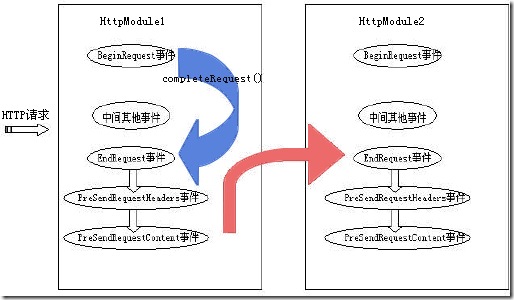
我是陈叙缘,这里是我的成才记录。如果喜欢我的博客(虽然不全是原创),可以关注我!!!
Coding!Let's go together and fly farther.
学习之路有你相伴,追梦之旅不孤单!




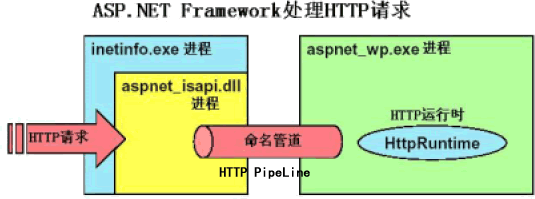
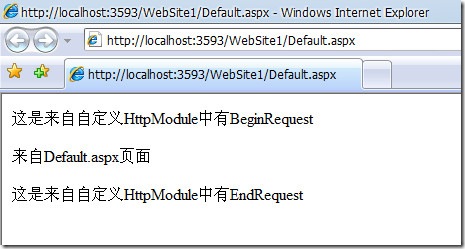
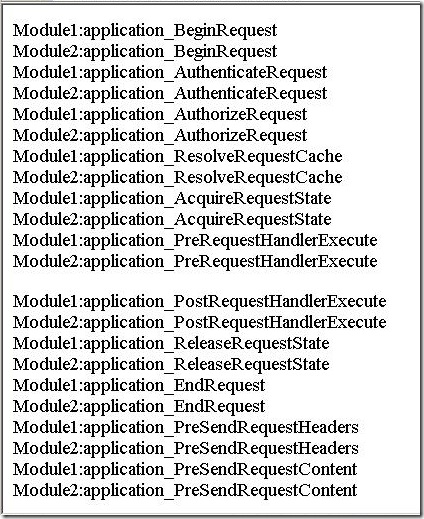
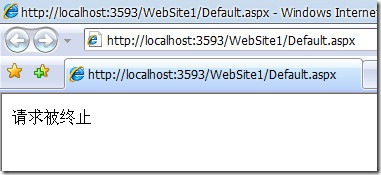

 浙公网安备 33010602011771号
浙公网安备 33010602011771号